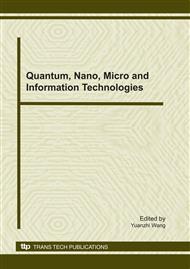[1]
P. Zahorik. Direct to reverberant energy ratio sensitivity. J. Acoustic Society in American. Vol. 115, No. 5, pp.2110-2117, (2002).
Google Scholar
[2]
Y. Nakayama, H. Okubo, K. Hamasaki, etc al. Distance control of sound image using line array loudspeaker for three-dimensional audio visual system. J. Acoustic Society in Japan. Vol. 35, No. 6, pp.3064-3069, (2005).
Google Scholar
[3]
E. G. Williams. Fourier acoustic: sound radiation and nearfield acoustical holography. London: Academic Press, 1999, pp.21-27.
Google Scholar
[4]
K. Nishikawa, H. Ohno, X. H. Tang etc al. A design method of 2D FIR fan filters for wideband beam forming by means of 2D fourier series approximation. Electronics and Communications in Japan, Part3, Vol. 85, No. 7, pp.38-48, (2002).
DOI: 10.1002/ecjc.1106
Google Scholar
[5]
T. Sekiguchi, Y. Karasawa. Wideband beamspace adaptive array utilizing FIR fan filters for multi-beam forming [J]. IEEE Transaction on Signal Processing, Vol. 48, No. 1, pp.277-283, (2000).
DOI: 10.1109/78.815503
Google Scholar
[6]
D. H. Johnson, D. E. Dudgeon. Array signal processing: concepts and techniques. Prentice Hall, 1993, pp.39-48.
Google Scholar
[7]
T. Takeuchi, P.A. Nelson. Optimal source distribution for binaural synthesis over loudspeakers. J. Acoust. Soc. Am. 112(6), pp.2786-2796, December (2002).
DOI: 10.1121/1.1513363
Google Scholar
[8]
J. Yang, W. Gan, and S. Tang. Development of virtual sound imaging system using Triple Elevated speakers. IEEE Trans. Consumer Electronics, Vol 50, No. 3, August (2004).
DOI: 10.1109/tce.2004.1341700
Google Scholar
[9]
N. Iwanaga, W. Kobayashi, and I. Shirakawa, Embedded implementation of acoustic field enhancement for stereo sound sources. IEEE Trans. Consumer Electronics, Vol. 49, NO. 3, Pp. 737-741, August, (2003).
DOI: 10.1109/tce.2003.1233812
Google Scholar
[10]
S. Boyd, L. Vendeberghe. convex optimization, Cambridge University press, (2004).
Google Scholar
[11]
J. Blauert. Spatial hearing: the psychophysics of human sound localization (Revised edition), MIT press, England, (1997).
Google Scholar
[12]
P.A. Nelson, J.F.W. Rose。Errors in two-point sound reproduction, J. Acoust. Soc. Am. 118(1), pp.193-204, July (2005).
Google Scholar


